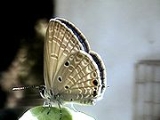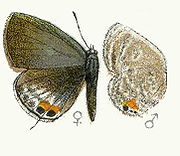
Edales pandava
Encyclopedia

Lycaenidae
The Lycaenidae are the second-largest family of butterflies, with about 6000 species worldwide, whose members are also called gossamer-winged butterflies...
butterfly found in India
India
India , officially the Republic of India , is a country in South Asia. It is the seventh-largest country by geographical area, the second-most populous country with over 1.2 billion people, and the most populous democracy in the world...
. They are among the few butterflies that breed on plants of the cycad
Cycad
Cycads are seed plants typically characterized by a stout and woody trunk with a crown of large, hard and stiff, evergreen leaves. They usually have pinnate leaves. The individual plants are either all male or all female . Cycads vary in size from having a trunk that is only a few centimeters...
family.
Wet-season brood
Male upperside is lavender-blue. Fore wing has the costa narrowly and terminal margin more broadly fuscous brown, the latter with in addition an anticiliary black line; cilia light brown transversely traversed close to but not at their bases by a dark brown line. Hind wing: costa narrowly fuscous brown; a sub-terminal series of black spots outwardly edged by a white line; the spot in interspace 2 the largest and inwardly crowned more or less broadly with ochraceous yellow; an anticiliary black line and the cilia as on the fore wing.Underside: greyish brown. Fore and hind wings: the following transverse darker brown markings on each wing, the markings edged on the inner and outer sides with white lines—a short bar across the discocellulars, a discal catenulated band, the posterior two elongate spots of which on the fore wing are en Echelon, while the band on the hind wing in bisinuate and is capped anteriorly near the costa by a round black spot encircled with white; the above are followed by maculated inner and outer subterminal bands, which on the hind wing are curved and more or less interrupted on the tornal area by a comparatively large round black spot ill interspace 2 and a smaller similar spot in interspace 1, both spots inwardly crowned with ochraceous; the white edgings on the inner side to both sub-terminal bands on the hind wing are more or less lunular. In addition on the same wing there is a subbasal curved row of four white-encircled spots, of which the anterior two and the spot on the dorsum are black, the other dark brown. Antennae black, shafts ringed with white; head, thorax and abdomen brown, the head and thorax clothed with bluish hairs; beneath: palpi, thorax and abdomen whitish.
Female upperside: brown. Fore wing: shot with blue from base outwards for a little over half its length down its middle, this blue irroration not extended to the costal margin; a slender anticiliary black line. Hind wing: a touch of blue iridescence near base; terminal markings much as on the forewing but the subterminal spots larger and not extended beyond interspace 6 ; in addition postdiscally there is a lightening of the shade of the ground-colour, between which paler area and the subterminal spots tho ground-colour assumes the form of a post-discal, short, transverse lunular band.
Underside of female as in the male, the markings slightly larger and more clearly defined. Antennae, head, thorax and abdomen as in the male but slightly paler.
Dry season brood
Very similar to the same sexes of the wet-season brood, but can be recognized by the following differences:—Upperside: Male Ground-colour slightly duller; sub-terminal spots on the hind wing less clearly defined. Female: The blue shot area extended outwards on the fore wing for three-fourths of its length from base, but as in wet-season specimens not reaching the costal margin; on the hind wing the blue suffusion covers the entire medial portion of the wing from the base to the subterminal row of spots, of which latter the spot in interspace 2 is entirely without the inner ochraceous edging.Underside: ground-colour darker than in specimens of the wet-season brood, the discocellular and discal transverse bands on both fore and hind wings broader, the terminal markings very ill-defined, the inner white edging to the inner of the two subterminal transverse bands broadened and very diffuse. On the hind wing the discocellular and discal bands coalesce and form an ill-defined diffuse medial cloud on the wing.
Distribution
Peninsular India south of the outer ranges of the Himalayas, but not in the desert tracts and somewhat local; Ceylon: Assam: Burma; extending into the Malayan Subregion.Larva
"When full-grown a little over half an inch in length, of two distinct colours, some being bright green, others of a dark reddish purple (vinous) .... head very small, black, shining and hidden beneath the second segment, the third segment larger than the second, the other segments about equal in size, the anal segment flattened and rounded, divisions between the segments well-marked. The larva throughout is very rough, widely pitted or depressed and covered with very minute white tubercles bearing very short fine hairs, neither the hairs nor the tubercles being visible without a lens. The body at its highest and widest part is wider than high. It is extremely variable in its markings, hardly any two being exactly alike; there is usually a dark, dorsal, subdorsal and lateral line dividing the upper surface of the body into three equal areas, the dorsal and two subdorsal lines coalescing on the eleventh segment and forming a broad band to the thirteenth. In some specimens the divisions between the segments are marked with darker and there is a subdorsal series of oblique dark lines, one on each segment between the dorsal and subdorsal lines. The underside of the body and legs seems to be always green. The erectile organs on the twelfth segment very small, feeds in Calcutta on Cycas revolutaCycas revoluta
Cycas revoluta , is a plant native to southern Japan. Though often known by the common name of king sago palm, or just sago palm, it is not a palm at all, but a cycad.-Description:...
. In Calcutta three species of ants attend this larva, which Professor Forel has identified for me as Prenolepis longicornis, Latr., Monomorium speculare, Mayr and Crematogaster, n. sp." (Lionel de Nicéville
Lionel de Nicéville
Charles Lionel Augustus de Nicéville was a curator at the Indian Museum in Calcutta . He studied the butterflies of South Asia and wrote a three volume monograph on the butterflies of India, Pakistan, Burma and Sri Lanka.Born in a noble Huguenot family, his father was a physician. He was educated...
quoted in Bingham)

